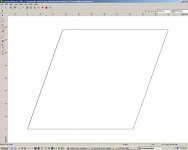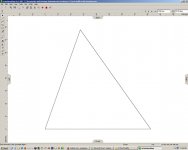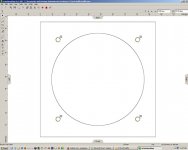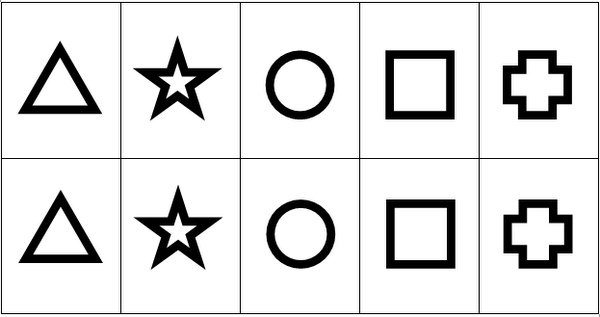Very cool looking enclosures. What adhesive did you use?
This enclosure style is heavily triangulated, and should have reduced panel resonances and standing waves, as well as pretty decent diffraction characteristics. Also, they are very styley. Frankly, I don't buy the hocus pocus either, but despite that I think these are pretty smart cabinets.
Frankly, I don't buy the hocus pocus either, but despite that I think these are pretty smart cabinets.
Hypercubes are a 4 dimensional mathematical concept and don't exist in 3 dimensional reality.
These are made from polycarbonate I take it?
This enclosure style is heavily triangulated, and should have reduced panel resonances and standing waves, as well as pretty decent diffraction characteristics. Also, they are very styley.
Hypercubes are a 4 dimensional mathematical concept and don't exist in 3 dimensional reality.
These are made from polycarbonate I take it?
Last edited:
gmad,
This is a cool looking speaker design, and your measurements are interesting. But, as many here have expressed, I find the explanation for what's happening a bit out there. In your first post you mention this design being a breakthrough. As an engineer (and I think many on this forum would agree with me), I don't believe anything can be considered a breakthrough in technology unless the mechanism by which it works can be understood, and controlled. You may not be the one to derive the equations, or even the final operational theory, but in order to convince other's it's worth looking into you have show you really have something behaving different from the standard theory.
I suggest that in order to advance the understand of what's happening here, a comparison measurement to a spherical enclosure with a similar internal volume would be very helpful. That would likely show if the effects you are seeing are largely due to the external shape (baffle effects) or something else (possibly internal standing waves). And of course, the more you can document the setup and results the better.
I'm curious about that 1.55K resonance. I suspect it's a cabinet panel resonance. I'd like to see if I can model it. You've already said that the box you built has a speaker baffle edge length of 4.25" (the size of the square piece) and is made of acrylic. Please correct me if I have that wrong. What is the thickness of the material used?
This is a cool looking speaker design, and your measurements are interesting. But, as many here have expressed, I find the explanation for what's happening a bit out there. In your first post you mention this design being a breakthrough. As an engineer (and I think many on this forum would agree with me), I don't believe anything can be considered a breakthrough in technology unless the mechanism by which it works can be understood, and controlled. You may not be the one to derive the equations, or even the final operational theory, but in order to convince other's it's worth looking into you have show you really have something behaving different from the standard theory.
I suggest that in order to advance the understand of what's happening here, a comparison measurement to a spherical enclosure with a similar internal volume would be very helpful. That would likely show if the effects you are seeing are largely due to the external shape (baffle effects) or something else (possibly internal standing waves). And of course, the more you can document the setup and results the better.
I'm curious about that 1.55K resonance. I suspect it's a cabinet panel resonance. I'd like to see if I can model it. You've already said that the box you built has a speaker baffle edge length of 4.25" (the size of the square piece) and is made of acrylic. Please correct me if I have that wrong. What is the thickness of the material used?
Introduction
Gentlemen, I would like to intrude upon your deliberations. I am Matthew Kennedy, co-inventor of the technology under discussion.
Some have dismissed the idea of hypercube speakers as a hoax, or as quackery. Let me assure you that this is no hoax. There is no reason for us to try to fool experts like you. No monetary incentive, either. The patent expired in 1997 -- it is public domain now. No one is trying to sell you anything.
For those of you who say it is not patentable, I can assure you that it was. The patent was granted on November 4, 1980. To avoid philosophical arguments about hyperspace, we entitled it "Resonating Chamber'
Here is a link from Google patents, so you can see I am not pulling your legs:
±M§Q US4231446 - Resonating chamber - Google ±M§Q
I look forward to the opportunity to discuss the ramifications of this geometry and its acoustic behavior at length.
Gentlemen, I would like to intrude upon your deliberations. I am Matthew Kennedy, co-inventor of the technology under discussion.
Some have dismissed the idea of hypercube speakers as a hoax, or as quackery. Let me assure you that this is no hoax. There is no reason for us to try to fool experts like you. No monetary incentive, either. The patent expired in 1997 -- it is public domain now. No one is trying to sell you anything.
For those of you who say it is not patentable, I can assure you that it was. The patent was granted on November 4, 1980. To avoid philosophical arguments about hyperspace, we entitled it "Resonating Chamber'
Here is a link from Google patents, so you can see I am not pulling your legs:
±M§Q US4231446 - Resonating chamber - Google ±M§Q
I look forward to the opportunity to discuss the ramifications of this geometry and its acoustic behavior at length.
more details
I think I should share a little more about myself so that you will know I am not some mystic or guru of any kind. I must agree that injecting metaphysical metaphors into this discussion is not likely to be helpful.
I obtained my degree in Physics from UCF in 1981. After that I attended physics graduate school at FSU, where I was fortunate enough to meet P.A.M. Dirac while he was still alive. I had no idea he had moved there from England.
For those who object to the word "hypercube" with regard to this shape, I offer the following:
Mark Newbold's Rhombic Dodecahedron Page
Why the Rhombic Dodecahedron is a Shadow of the 4-Dimensional Hypercube
There is plenty of literature disclosing that the Rhombic Dodecahedron is geometrically isomorphic to the 3D boundary surface of the parallel projection of a 4D hypercube onto 3-space.
I didn't know this until after we had begun making prototypes. In fact, when we started back in 1977, I had never even *heard* of the rhombic dodecahedron.
It all started back in my undergraduate days, when I was trying to make a cardboard model of the Hinton diagram of a hypercube: the cube-within-a-cube drawing, usually referred to as the "perpendicular" projection of a hypercube onto 3-space.
I figured the easiest way to make my model was to make six truncated pyramids and fasten them together. But while I was taping the cardboard, I realized that there was two ways to put the pyramids together. Curious, I changed my plans and taped it together inside-out.
My friend Tom Weiss saw this and suggested it would be simpler to extend the pyramids to points. So we did that. We had never seen the resulting shape before. After some digging, we discovered that is was known to Kepler and others as the Rhombic Dodecahedron. Only much later did we learn that the RD is also related to the parallel projection of a hypercube.
I think I should share a little more about myself so that you will know I am not some mystic or guru of any kind. I must agree that injecting metaphysical metaphors into this discussion is not likely to be helpful.
I obtained my degree in Physics from UCF in 1981. After that I attended physics graduate school at FSU, where I was fortunate enough to meet P.A.M. Dirac while he was still alive. I had no idea he had moved there from England.
For those who object to the word "hypercube" with regard to this shape, I offer the following:
Mark Newbold's Rhombic Dodecahedron Page
Why the Rhombic Dodecahedron is a Shadow of the 4-Dimensional Hypercube
There is plenty of literature disclosing that the Rhombic Dodecahedron is geometrically isomorphic to the 3D boundary surface of the parallel projection of a 4D hypercube onto 3-space.
I didn't know this until after we had begun making prototypes. In fact, when we started back in 1977, I had never even *heard* of the rhombic dodecahedron.
It all started back in my undergraduate days, when I was trying to make a cardboard model of the Hinton diagram of a hypercube: the cube-within-a-cube drawing, usually referred to as the "perpendicular" projection of a hypercube onto 3-space.
I figured the easiest way to make my model was to make six truncated pyramids and fasten them together. But while I was taping the cardboard, I realized that there was two ways to put the pyramids together. Curious, I changed my plans and taped it together inside-out.
My friend Tom Weiss saw this and suggested it would be simpler to extend the pyramids to points. So we did that. We had never seen the resulting shape before. After some digging, we discovered that is was known to Kepler and others as the Rhombic Dodecahedron. Only much later did we learn that the RD is also related to the parallel projection of a hypercube.
Matt, good of you to join us.
Personally, I don't like to believe or dismiss anything without evidence. I'm not as experienced as many others here, but I have seen evidence that certain geometries can be very influential on audio. I'm also willing to believe the measurements presented indicate an improvement over rectangular boxes. However, I have not seen any convincing evidence here or on your website that anything beyond baffle effects make your speaker design any better.
Could you elaborate on your experimental findings? In particular, can you present the evidence you have that the internal geometry of your speaker box contributes greatly to the differences you have observed as compared to boxes designed using the standard Thiele/Small design equations?
Personally, I don't like to believe or dismiss anything without evidence. I'm not as experienced as many others here, but I have seen evidence that certain geometries can be very influential on audio. I'm also willing to believe the measurements presented indicate an improvement over rectangular boxes. However, I have not seen any convincing evidence here or on your website that anything beyond baffle effects make your speaker design any better.
Could you elaborate on your experimental findings? In particular, can you present the evidence you have that the internal geometry of your speaker box contributes greatly to the differences you have observed as compared to boxes designed using the standard Thiele/Small design equations?
but I have seen evidence that certain geometries can be very influential on audio.
That is certainly the case.
dave
+1. Cabinet geometry certainly is influential. The extent of course is another matter entirely, as Dave alluded to earlier in the thread.
As for patents, I should gently point out for the benefit of anyone reading who is not aware of the fact: just about anything can get patented. It doesn't matter if it is valid or drooling nonsense from a confirmed window-licker: if you can present it right & are willing to stump up the fee, you can get a patent.
This for instance: Home page This is a passive box that can be inserted anywhere in a system / signal chain, and irrespective of where it is or what the components are, it will dramatically increase system efficiency (upwards of 9 - 12dB can be attained with lower levels of distortion). Utter tosh of course, but it's patented. The patent basically indicates it's a box with a couple of wires in. See US 6,486,750.
Not daft enough for you yet? Try US patent number 6,025,810. It is, and I quote 'A method to transmit and receive electromagnetic waves... sending the signal at a speed faster than light.' Yes, you did read that correctly. And yes, the patent was granted. One can only speculate that the examiner either had a good sense of humour, or requires 'special' assistance. Thank you Rod Eliot for pointing these out on his website, but there are literally thousands of other examples. 99% of the patents or the patent applications made by hi-fi wire companies for instance. I have a collection of those for when I need a science-fiction fix.
As for patents, I should gently point out for the benefit of anyone reading who is not aware of the fact: just about anything can get patented. It doesn't matter if it is valid or drooling nonsense from a confirmed window-licker: if you can present it right & are willing to stump up the fee, you can get a patent.
This for instance: Home page This is a passive box that can be inserted anywhere in a system / signal chain, and irrespective of where it is or what the components are, it will dramatically increase system efficiency (upwards of 9 - 12dB can be attained with lower levels of distortion). Utter tosh of course, but it's patented. The patent basically indicates it's a box with a couple of wires in. See US 6,486,750.
Not daft enough for you yet? Try US patent number 6,025,810. It is, and I quote 'A method to transmit and receive electromagnetic waves... sending the signal at a speed faster than light.' Yes, you did read that correctly. And yes, the patent was granted. One can only speculate that the examiner either had a good sense of humour, or requires 'special' assistance. Thank you Rod Eliot for pointing these out on his website, but there are literally thousands of other examples. 99% of the patents or the patent applications made by hi-fi wire companies for instance. I have a collection of those for when I need a science-fiction fix.
Last edited:
Hello to Greg B and Mudd Jester:
Thanks for your inquiries and compliments. My enclosures are made of 6mm acrylic bonded with weldon #4. I don't personally believe there is any hocus-pocus going on here (my measurements seem to agree with my ears) but I've been fortunate enough to actually experience using these things and since I have had such a good musical experience with them, I suppose I'm biased now. I'm sure the diffraction characteristics are improved with respect to a rectangular box, but I don't know exactly how much that plays into the measured/observed sound. What the measurements don't show (at least yet) is that the panels seem to resonate over a wide frequency range. I feel it when holding the speaker during play. My measurements were made with the microphone ~2" from the driver (closer than the pictures show) and ~41" from the floor/wall/ceiling. I'm happy to provide as much information as possible so please let me know if there are other measurements I should attempt. --Greg
Thanks for your inquiries and compliments. My enclosures are made of 6mm acrylic bonded with weldon #4. I don't personally believe there is any hocus-pocus going on here (my measurements seem to agree with my ears) but I've been fortunate enough to actually experience using these things and since I have had such a good musical experience with them, I suppose I'm biased now. I'm sure the diffraction characteristics are improved with respect to a rectangular box, but I don't know exactly how much that plays into the measured/observed sound. What the measurements don't show (at least yet) is that the panels seem to resonate over a wide frequency range. I feel it when holding the speaker during play. My measurements were made with the microphone ~2" from the driver (closer than the pictures show) and ~41" from the floor/wall/ceiling. I'm happy to provide as much information as possible so please let me know if there are other measurements I should attempt. --Greg
Sounds like a perfect use for foam core panels.What the measurements don't show (at least yet) is that the panels seem to resonate over a wide frequency range. I feel it when holding the speaker during play.
"However, I have not seen any convincing evidence here or on your website that anything beyond baffle effects make your speaker design any better."
Hi again Muddjester. I'm sorry to butt-in here as I know this was directed to Matthew Kennedy, but I don't see how the reduced harmonic distortion and improved decay (both in the bass range) indicated by my measurements could be solely attributed to baffle effects (or lack thereof). --Greg
Hi again Muddjester. I'm sorry to butt-in here as I know this was directed to Matthew Kennedy, but I don't see how the reduced harmonic distortion and improved decay (both in the bass range) indicated by my measurements could be solely attributed to baffle effects (or lack thereof). --Greg
Gentlemen:
I agree it is possible to patent almost anything, if you pony up the dough and persist long enough in rebutting the replies from the patent Office regarding prior art, etc. The existence of a patent does not in itself prove anything. In fact, I believe the latest statistics show that approximately half (!) of all applications are granted. This is especially true in the area of Design patents, which are merely cosmetic. Ours was a Utility patent, however, and not a design one. In the case of a utility patent, you do not have to present a working prototype, however, unless the application is for antigravity or something equally questionable. You do, however, have to attempt to show that a utility patent application is (1) distinct from prior art (2) sufficiently novel that someone would not think of it easily and (3) offers advantages over prior art.
I have the greatest of respect for those who apply science to make non-lethal technology for the enjoyment of human beings -- such as audio engineers. There are times when I sincerely wish that our discovery did not tread on the toes of people who have spent large portions of their lives learning how to design audio components such as loudspeaker cabinets.
Engineers apply science, not wishful thinking. And we all know how science works. Extraordinary claims require extraordinary evidence. I accept that.
Let's keep in mind that that the Thiele-Small theory is just that -- a theory. It has been applied for many years now, but it is still subject to modification by subsequent discoveries. It is always possible that any theory, however useful or accepted, may encounter cases or situations where it is, shall we say, not entirely applicable.
And by the way, I must apologize for my pedantic and lecturing tone. Back in my undergraduate days, I remember my professor for Professional Report Writing telling me that I wrote "too formally." LMAO! It was an eye-opener. I thought i was striking the write tone for a professional report...but she called me on it anyway.
I agree it is possible to patent almost anything, if you pony up the dough and persist long enough in rebutting the replies from the patent Office regarding prior art, etc. The existence of a patent does not in itself prove anything. In fact, I believe the latest statistics show that approximately half (!) of all applications are granted. This is especially true in the area of Design patents, which are merely cosmetic. Ours was a Utility patent, however, and not a design one. In the case of a utility patent, you do not have to present a working prototype, however, unless the application is for antigravity or something equally questionable. You do, however, have to attempt to show that a utility patent application is (1) distinct from prior art (2) sufficiently novel that someone would not think of it easily and (3) offers advantages over prior art.
I have the greatest of respect for those who apply science to make non-lethal technology for the enjoyment of human beings -- such as audio engineers. There are times when I sincerely wish that our discovery did not tread on the toes of people who have spent large portions of their lives learning how to design audio components such as loudspeaker cabinets.
Engineers apply science, not wishful thinking. And we all know how science works. Extraordinary claims require extraordinary evidence. I accept that.
Let's keep in mind that that the Thiele-Small theory is just that -- a theory. It has been applied for many years now, but it is still subject to modification by subsequent discoveries. It is always possible that any theory, however useful or accepted, may encounter cases or situations where it is, shall we say, not entirely applicable.
And by the way, I must apologize for my pedantic and lecturing tone. Back in my undergraduate days, I remember my professor for Professional Report Writing telling me that I wrote "too formally." LMAO! It was an eye-opener. I thought i was striking the write tone for a professional report...but she called me on it anyway.
Thiele Small has to do with the model of an electrodynamic voice coil type driver. It has nothing to do with the enclosure except that it provides a way to model the response of that driver in that cabinet. Thiele Small essentially is the lumped element network model of a driver with parameters equivalent to capacitors, inductors, and resistors. As such, one can add it as part of a larger system of lumped element 1d models often used to model and simulate speaker enclosures such as sealed, bass reflex, back loaded horn, transmission lines, etc. Having an enclosure with geometry that is unusual doesn't change a drivers' Thiele Small parameters which are an intrinsic property of the driver. You will not get far around here saying that Thiele Small is only a theory. It is backed by thousands of successful and accurate simulations of speakers and drivers. Yes, it is phenomenological, but like F=ma, Newtons' second law (also phenomenological) - it is pretty darned good.
I actually look forward to making one of these 'hypercubes' because they look cool and would be fun to build. But I bet if you measured a spherical speaker with the same volume it will be very similar.
I actually look forward to making one of these 'hypercubes' because they look cool and would be fun to build. But I bet if you measured a spherical speaker with the same volume it will be very similar.
- Status
- This old topic is closed. If you want to reopen this topic, contact a moderator using the "Report Post" button.
- Home
- Loudspeakers
- Full Range
- Hypercube Loudspeakers



